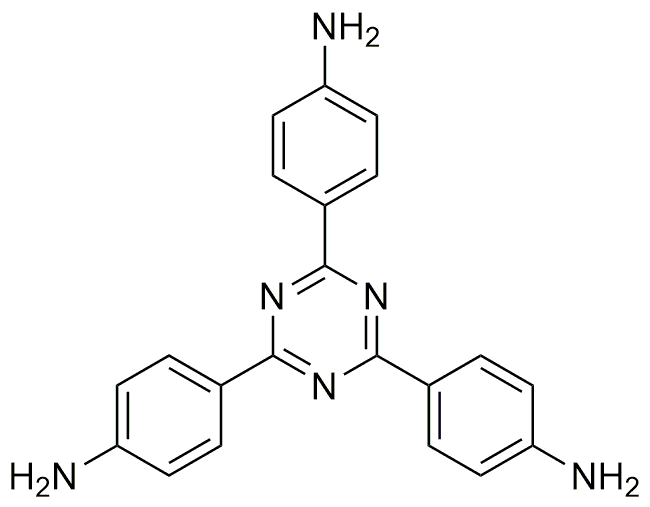4,4',4''-(1,3,5-Triazine-2,4,6-triyl)trianiline is widely utilized in research focused on:
- Polymer Chemistry: This compound serves as a key building block in the synthesis of high-performance polymers, enhancing thermal stability and mechanical properties, making it ideal for applications in aerospace and automotive industries.
- Organic Electronics: It is used in the development of organic light-emitting diodes (OLEDs) and organic photovoltaics (OPVs), where its unique electronic properties improve efficiency and longevity compared to traditional materials.
- Anti-Corrosion Coatings: The chemical's properties make it effective in formulating coatings that protect metals from corrosion, especially in harsh environments, benefiting industries like construction and marine.
- Pharmaceuticals: It plays a role in drug development, particularly in creating targeted delivery systems that enhance bioavailability and reduce side effects, which is crucial for improving patient outcomes.
- Environmental Applications: This compound is explored for use in adsorbents for water purification, effectively removing pollutants and heavy metals, thus contributing to cleaner water solutions.
General Information
Properties
Safety and Regulations
Applications
4,4',4''-(1,3,5-Triazine-2,4,6-triyl)trianiline is widely utilized in research focused on:
- Polymer Chemistry: This compound serves as a key building block in the synthesis of high-performance polymers, enhancing thermal stability and mechanical properties, making it ideal for applications in aerospace and automotive industries.
- Organic Electronics: It is used in the development of organic light-emitting diodes (OLEDs) and organic photovoltaics (OPVs), where its unique electronic properties improve efficiency and longevity compared to traditional materials.
- Anti-Corrosion Coatings: The chemical's properties make it effective in formulating coatings that protect metals from corrosion, especially in harsh environments, benefiting industries like construction and marine.
- Pharmaceuticals: It plays a role in drug development, particularly in creating targeted delivery systems that enhance bioavailability and reduce side effects, which is crucial for improving patient outcomes.
- Environmental Applications: This compound is explored for use in adsorbents for water purification, effectively removing pollutants and heavy metals, thus contributing to cleaner water solutions.
Documents
Safety Data Sheets (SDS)
The SDS provides comprehensive safety information on handling, storage, and disposal of the product.
Product Specification (PS)
The PS provides a comprehensive breakdown of the product’s properties, including chemical composition, physical state, purity, and storage requirements. It also details acceptable quality ranges and the product's intended applications.
Certificates of Analysis (COA)
Search for Certificates of Analysis (COA) by entering the products Lot Number. Lot and Batch Numbers can be found on a product’s label following the words ‘Lot’ or ‘Batch’.
*Catalog Number
*Lot Number
Certificates Of Origin (COO)
This COO confirms the country where the product was manufactured, and also details the materials and components used in it and whether it is derived from natural, synthetic, or other specific sources. This certificate may be required for customs, trade, and regulatory compliance.
*Catalog Number
*Lot Number
Safety Data Sheets (SDS)
The SDS provides comprehensive safety information on handling, storage, and disposal of the product.
DownloadProduct Specification (PS)
The PS provides a comprehensive breakdown of the product’s properties, including chemical composition, physical state, purity, and storage requirements. It also details acceptable quality ranges and the product's intended applications.
DownloadCertificates of Analysis (COA)
Search for Certificates of Analysis (COA) by entering the products Lot Number. Lot and Batch Numbers can be found on a product’s label following the words ‘Lot’ or ‘Batch’.
*Catalog Number
*Lot Number
Certificates Of Origin (COO)
This COO confirms the country where the product was manufactured, and also details the materials and components used in it and whether it is derived from natural, synthetic, or other specific sources. This certificate may be required for customs, trade, and regulatory compliance.


